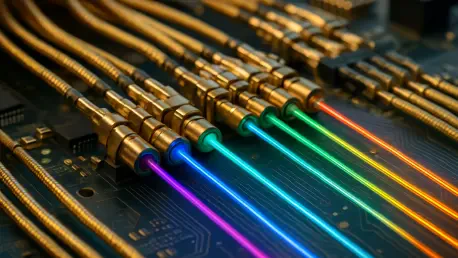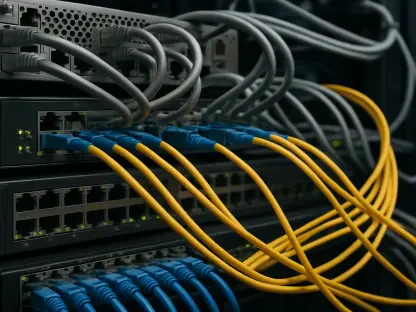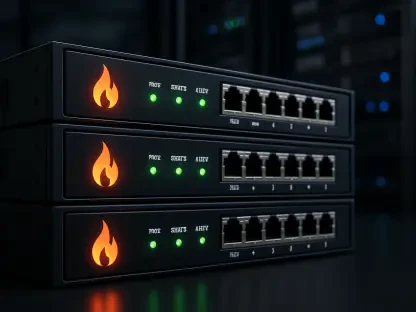In an era where artificial intelligence (AI) is reshaping the technological landscape, data centers are grappling with unprecedented demands to support increasingly complex models that require immense computational power. Gone are the days when a single GPU could handle AI workloads; today’s systems rely on sprawling clusters of hundreds of thousands of GPUs working in unison. However, traditional copper-based connections, once the backbone of data center infrastructure, are faltering under the pressure of limited bandwidth, excessive heat generation, and skyrocketing energy consumption. This critical juncture has paved the way for a transformative solution: photonic interconnects. Utilizing light to transmit data, this cutting-edge technology promises to redefine how information flows within these high-stakes environments, addressing the core challenges of modern AI-driven facilities. As the industry races to keep pace with innovation, photonics emerges as a beacon of hope for scalable, efficient, and sustainable data movement.
Unleashing the Potential of Light-Based Connectivity
The advent of photonic interconnects marks a pivotal shift in addressing the connectivity woes plaguing AI data centers. Unlike copper connections, which struggle with data transmission over distances beyond a few meters due to signal degradation and thermal issues, photonics harnesses light to deliver staggering bandwidth and remarkably low latency. Innovations in this space, such as those pioneered by leading tech firms, have demonstrated a dramatic reduction in energy use—slashing it from 55 picojoules per bit with copper to just 13 picojoules per bit. This efficiency translates into substantial cost savings on power bills while also alleviating the heat buildup that often hampers GPU performance. By enabling faster and more reliable data transfers, photonic technology ensures that expensive hardware operates at peak capacity, eliminating bottlenecks that have long hindered computational efficiency in sprawling AI setups.
Beyond its raw performance benefits, photonic technology reimagines the very architecture of data centers. With the ability to connect GPUs across vast distances—spanning entire racks or even facilities—photonics facilitates the creation of massive, disaggregated clusters that function as a single, cohesive unit. This overcomes the physical limitations imposed by copper, where thermal constraints prevent dense packing of hardware. Advanced solutions, like optical multi-chip interface bridges, further optimize space by integrating high-speed connections into compact designs. Such innovations not only enhance performance but also allow for flexible scaling, accommodating the ever-growing needs of AI workloads without requiring a complete overhaul of existing infrastructure. This architectural leap positions photonics as a cornerstone for building the next generation of intelligent data environments.
Shifting the Focus to Data Movement
A profound realization is sweeping through the data center industry: the true challenge lies not in raw computational power, but in the inefficient movement of data. A staggering statistic reveals that approximately 60% of a data center’s energy consumption is devoted to transferring information rather than processing it. This imbalance results in inflated operational costs and drags down GPU utilization rates, a critical measure of how effectively hardware performs its intended tasks. As AI models grow in complexity, requiring seamless communication across thousands of interconnected GPUs, the limitations of traditional interconnects become glaringly apparent. The industry is now compelled to rethink foundational designs, prioritizing solutions that streamline data flow over simply boosting compute capacity, marking a significant paradigm shift in infrastructure strategy.
This focus on data movement has elevated photonic interconnects to a position of critical importance. By drastically cutting down on the energy required for data transmission, photonics addresses the core inefficiency that has long plagued data centers. The technology’s ability to support high-speed, long-distance connections without the thermal penalties associated with copper enables a reimagining of how resources are allocated and utilized. Industry experts view these advancements as essential to transforming data centers into high-efficiency “AI factories,” where the production of tokens—the fundamental outputs of AI models—is maximized. This shift underscores a broader trend toward designing infrastructure that can sustainably handle the relentless expansion of AI applications without succumbing to prohibitive energy demands or performance lags.
Energy Efficiency as a Core Design Principle
As data centers evolve to meet the demands of AI, energy efficiency has emerged as a non-negotiable benchmark for sustainable design. With data movement consuming the majority of power in modern facilities, the economic and environmental implications are profound. Inefficient systems not only inflate costs but also contribute to a larger carbon footprint, raising concerns about the long-term viability of current infrastructure models. The push for greener technologies is no longer a peripheral goal but a central focus, as stakeholders recognize that unchecked energy consumption could derail the progress of AI innovation. Solutions that minimize power usage per bit of data transferred are now seen as indispensable to maintaining both profitability and ecological responsibility in this rapidly expanding field.
Photonic interconnects stand at the forefront of this energy efficiency revolution, offering a lifeline to an industry under pressure. By leveraging light-based transmission, the technology achieves significant reductions in power draw, enabling data centers to operate at scale without the burden of excessive energy costs. This capability is particularly crucial as AI workloads continue to grow, demanding ever-larger clusters of GPUs that must communicate seamlessly. The consensus among industry leaders is that without such advancements, the trajectory of AI infrastructure risks becoming unsustainable. Photonics not only addresses immediate power concerns but also sets a precedent for future innovations, ensuring that data centers can evolve in tandem with technological progress while adhering to stringent efficiency standards that benefit both operators and the environment.
Building Tomorrow’s AI Infrastructure
Reflecting on the journey, the industry took bold strides to confront the limitations of traditional data center designs, particularly in the face of AI’s unprecedented growth. Photonic interconnects emerged as a transformative force, tackling the inefficiencies of copper-based systems and redefining how data is moved across vast computational landscapes. The remarkable reduction in energy consumption and the architectural flexibility offered by light-based technology reshaped the operational dynamics of these critical facilities. Through persistent innovation, the groundwork was laid for a new era where connectivity challenges no longer stifled progress, allowing AI models to scale without the constraints of outdated infrastructure.
Looking ahead, the path forward involves a sustained commitment to integrating photonic solutions into mainstream data center designs. Stakeholders must prioritize investment in research and development to refine this technology, ensuring it can adapt to emerging AI demands over the coming years. Collaboration between tech pioneers and infrastructure providers will be key to scaling photonic implementations, making them accessible across diverse operational contexts. Additionally, establishing industry standards for energy-efficient data movement can accelerate adoption, fostering an ecosystem where sustainability and performance go hand in hand. As these efforts unfold, the vision of data centers as efficient “AI factories” will solidify, driving innovation while safeguarding economic and environmental priorities for future generations.









